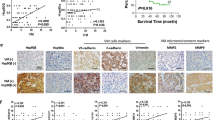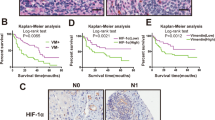Abstract
Vasculogenic mimicry (VM), including tubular VM and patterned matrix VM, has been generally recognized as a new pattern of tumor neovascularization. Pilot studies of tubular VM showed that it was present in hepatocellular carcinoma (HCC) and associated with poor clinical prognosis. However, whether patterned matrix VM is clinically significant in HCC is unknown. To elucidate the effects of patterned matrix VM on prognosis of HCC and the mechanisms involved in VM formation, we examined 151 cases of surgically resected human HCC by immunohistochemistry and transmission electron microscopy and conducted hypoxic experiments on human HCC cell line MHCC97-H. We observed 31 of 151 (20.5%) cases exhibited evidence of patterned matrix VM. The expression of patterned matrix VM was associated with larger tumors (P = 0.042), vascular invasion (P = 0.016), high-grade HCC (P = 0.022), and late-stage HCC (P = 0.013). Kaplan–Meier survival analysis revealed that cases of the VM group had lower overall survival (OS) rate (P < 0.001) and disease-free survival (DFS) rate (P = 0.002) than that of the non-VM group. Univariate and multivariate analysis indicated that the presence of patterned matrix VM was independent adverse prognostic factor for both OS (P = 0.004) and DFS (P = 0.011). Expression of hypoxia-inducible factor 1 alpha (HIF-1alpha), matrix metalloproteinase (MMP)-2, and MMP-9 were higher in the VM group than in the non-VM group (P = 0.001, P = 0.030, P = 0.007, respectively). After VM formation was induced by hypoxia, up-regulated expression of HIF-1α, MMP-2, and MMP-9 was also detected in cells cultured under hypoxia condition. Our results indicate that patterned matrix VM exists in HCC, and it might serve as an unfavorable prognostic factor for HCC patients. It is possible that hypoxia via induction of expression of HIF-1alpha, MMP-2, and MMP-9 may enhance VM formation in HCC.






Similar content being viewed by others
References
Carmeliet P. Angiogenesis in health and disease. Nat Med. 2003;9(6):653–60.
Chang YS, et al. Mosaic blood vessels in tumors: frequency of cancer cells in contact with flowing blood. Proc Natl Acad Sci USA. 2000;97(26):14608–13.
Semela D, Dufour JF. Angiogenesis and hepatocellular carcinoma. J Hepatol. 2004;41(5):864–80.
Maniotis AJ, et al. Vascular channel formation by human melanoma cells in vivo and in vitro: vasculogenic mimicry. Am J Pathol. 1999;155(3):739–52.
Folberg R, Maniotis AJ. Vasculogenic mimicry. APMIS. 2004;112(7–8):508–25.
Guzman G, Cotler SJ, Lin AY, Maniotis AJ, Folberg R. A pilot study of vasculogenic mimicry immunohistochemical expression in hepatocellular carcinoma. Arch Pathol Lab Med. 2007;131(12):1776–81.
Hendrix MJ, Seftor EA, Hess AR, Seftor RE. Vasculogenic mimicry and tumour-cell plasticity: lessons from melanoma. Nat Rev Cancer. 2003;3(6):411–21.
Lissitzky JC, et al. Cyclic AMP signaling as a mediator of vasculogenic mimicry in aggressive human melanoma cells in vitro. Cancer Res. 2009;69(3):802–9.
Basu GD, et al. A novel role for cyclooxygenase-2 in regulating vascular channel formation by human breast cancer cells. Breast Cancer Res. 2006;8(6):R69.
Robertson FM, et al. Differential regulation of the aggressive phenotype of inflammatory breast cancer cells by prostanoid receptors EP3 and EP4. Cancer. 2010;116(11 Suppl):2806–14.
Sharma N, et al. Prostatic tumor cell plasticity involves cooperative interactions of distinct phenotypic subpopulations: role in vasculogenic mimicry. Prostate. 2002;50(3):189–201.
Sood AK, et al. Functional role of matrix metalloproteinases in ovarian tumor cell plasticity. Am J Obstet Gynecol. 2004;190(4):899–909.
Scavelli C, et al. Vasculogenic mimicry by bone marrow macrophages in patients with multiple myeloma. Oncogene. 2008;27(5):663–74.
van der Schaft DW, et al. Tumor cell plasticity in Ewing sarcoma, an alternative circulatory system stimulated by hypoxia. Cancer Res. 2005;65(24):11520–8.
Zhang LZ, et al. The role of VE-cadherin in osteosarcoma cells. Pathol Oncol Res. 2010;16(1):111–7.
El Hallani S, et al. A new alternative mechanism in glioblastoma vascularization: tubular vasculogenic mimicry. Brain. 2010;133(Pt 4):973–82.
Li M, et al. Vasculogenic mimicry: a new prognostic sign of gastric adenocarcinoma. Pathol Oncol Res. 2010;16(2):259–66.
Baeten CI, Hillen F, Pauwels P, de Bruine AP, Baeten CG. Prognostic role of vasculogenic mimicry in colorectal cancer. Dis Colon Rectum. 2009;52(12):2028–35.
Vartanian AA, et al. Prognostic significance of periodic acid-Schiff-positive patterns in clear cell renal cell carcinoma. Can J Urol. 2009;16(4):4726–32.
Mirshahi P, et al. Vasculogenic mimicry of acute leukemic bone marrow stromal cells. Leukemia. 2009;23(6):1039–48.
Sun B, et al. Vasculogenic mimicry is associated with high tumor grade, invasion and metastasis, and short survival in patients with hepatocellular carcinoma. Oncol Rep. 2006;16(4):693–8.
Dupuy E, et al. Tumoral angiogenesis and tissue factor expression during hepatocellular carcinoma progression in a transgenic mouse model. J Hepatol. 2003;38(6):793–802.
Sun T, et al. Expression and functional significance of Twist1 in hepatocellular carcinoma: its role in vasculogenic mimicry. Hepatology. 2010;51(2):545–56.
Crowther M, Brown NJ, Bishop ET, Lewis CE. Microenvironmental influence on macrophage regulation of angiogenesis in wounds and malignant tumors. J Leukoc Biol. 2001;70(4):478–90.
Liu SY, et al. Clinicopathologic significance of tumor cell-lined vessel and microenvironment in oral squamous cell carcinoma. Oral Oncol. 2008;44(3):277–85.
Sun B, et al. Hypoxia influences vasculogenic mimicry channel formation and tumor invasion-related protein expression in melanoma. Cancer Lett. 2007;249(2):188–97.
Mattern J, Koomagi R, Volm M. Association of vascular endothelial growth factor expression with intratumoral microvessel density and tumour cell proliferation in human epidermoid lung carcinoma. Br J Cancer. 1996;73(7):931–4.
Yamamoto K, et al. Proliferation, differentiation, and tube formation by endothelial progenitor cells in response to shear stress. J Appl Physiol. 2003;95(5):2081–8.
Sood AK, et al. Molecular determinants of ovarian cancer plasticity. Am J Pathol. 2001;158(4):1279–88.
Folkman J. Can mosaic tumor vessels facilitate molecular diagnosis of cancer? Proc Natl Acad Sci USA. 2001;98(2):398–400.
Massi D, et al. Vasculogenic mimicry has no prognostic significance in pT3 and pT4 cutaneous melanoma. Hum Pathol. 2004;35(4):496–502.
Vengellur A, Phillips JM, Hogenesch JB, LaPres JJ. Gene expression profiling of hypoxia signaling in human hepatocellular carcinoma cells. Physiol Genomics. 2005;22(3):308–18.
Wu XZ, Xie GR, Chen D. Hypoxia and hepatocellular carcinoma: The therapeutic target for hepatocellular carcinoma. J Gastroenterol Hepatol. 2007;22(8):1178–82.
Dai CX, et al. Hypoxia-inducible factor-1 alpha, in association with inflammation, angiogenesis and MYC, is a critical prognostic factor in patients with HCC after surgery. BMC Cancer. 2009;9:418.
Bertout JA, Patel SA, Simon MC. The impact of O2 availability on human cancer. Nat Rev Cancer. 2008;8(12):967–75.
Zhang S, Zhang D, Sun B. Vasculogenic mimicry: current status and future prospects. Cancer Lett. 2007;254(2):157–64.
Seftor RE, et al. Cooperative interactions of laminin 5 gamma2 chain, matrix metalloproteinase-2, and membrane type-1-matrix/metalloproteinase are required for mimicry of embryonic vasculogenesis by aggressive melanoma. Cancer Res. 2001;61(17):6322–7.
Annabi B, et al. Hypoxia promotes murine bone-marrow-derived stromal cell migration and tube formation. Stem Cells. 2003;21(3):337–47.
Ottino P, et al. Hypoxia activates matrix metalloproteinase expression and the VEGF system in monkey choroid-retinal endothelial cells: Involvement of cytosolic phospholipase A2 activity. Mol Vis. 2004;10:341–50.
Acknowledgments
This study was supported by the National Natural Science Foundation of China (30972892), the Science and Technology Key Project of Anhui Province (07010302193), Anhui Provincial Natural Science Foundation (090413107), Anhui Provincial College Natural Science Key Project (KJ2009A178), the Science and Technological Fund of Anhui Province for Outstanding Youth (08040106818), and the Anhui Provincial ‘‘115’’ Industrial Innovation Program.
Author information
Authors and Affiliations
Corresponding author
Additional information
Wen-bin Liu and Wei-dong Jia contributed equally to this work.
Rights and permissions
About this article
Cite this article
Liu, Wb., Xu, Gl., Jia, Wd. et al. Prognostic significance and mechanisms of patterned matrix vasculogenic mimicry in hepatocellular carcinoma. Med Oncol 28 (Suppl 1), 228–238 (2011). https://doi.org/10.1007/s12032-010-9706-x
Received:
Accepted:
Published:
Issue Date:
DOI: https://doi.org/10.1007/s12032-010-9706-x




